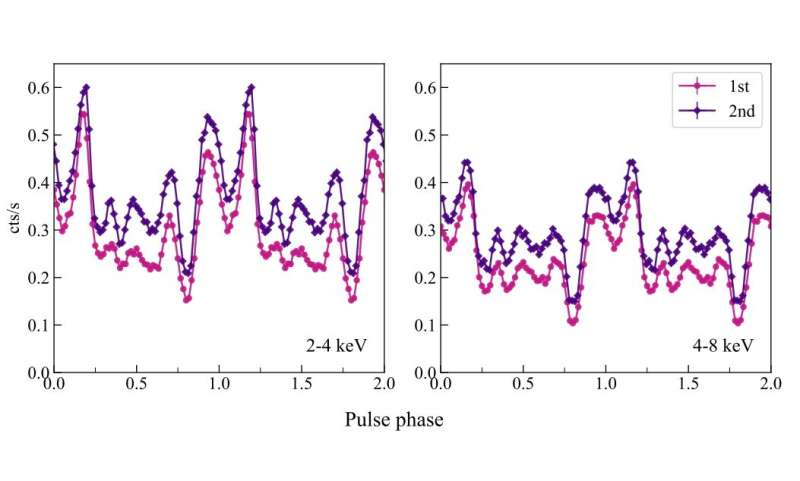March 13, 2023 report
This article has been reviewed according to Science X's editorial process and policies. Editors have highlighted the following attributes while ensuring the content's credibility:
fact-checked
preprint
trusted source
proofread
Observations inspect X-ray radiation from Vela X-1

Using the Imaging X-ray Polarimetry Explorer (IXPE), an international team of astronomers has conducted X-ray polarimetric observations of an accreting X-ray pulsar known as Vela X-1. Results of the observational campaign, presented March 3 on the arXiv pre-print server, deliver important insights into the properties of X-ray radiation from this pulsar.
X-ray binaries are composed of a normal star or a white dwarf transferring mass onto a compact neutron star or a black hole. Based on the mass of the companion star, astronomers divide them into low-mass X-ray binaries (LMXBs) and high-mass X-ray binaries (HMXBs).
At a distance of some 6,500 light years away from the Earth, Vela X-1 is a runaway high-mass X-ray binary (HMXB) system, consisting of an accreting neutron star and the supergiant donor HD 77581 in a tight 9-day orbit. HD 77581 launches a strong stellar wind that causes a bow shock as it interacts with the interstellar medium. This makes Vela X-1 one of only two HMXBs known to experience a bow shock.
Recently, a group of astronomers led by Sofia Forsblom of the University of Turku in Finland, has investigated Vela X-1 with IXPE, hoping to shed more light on the nature of this pulsar.
"In this paper, we present the first results of X-ray polarimetric observations of Vela X-1 by IXPE carried out on two separate occasions during 2022," the researchers wrote.
First of all, the team measured the spin period of Vela X-1 using the phase connection technique, which was found to be approximately 283.4 seconds. The pulsed fraction in the 2–8 keV energy band was determined to be 53.3% for the first observation and 48.1% for the second observation.
Afterward, it was found that In the entire IXPE energy band (2–8 keV), the average polarization degree (PD) and polarization angle (PA) are at a level of about 3.9% and −51.5 degrees, respectively, for the first observation. For the second observation, the average PD and PA were measured to be 3.7% and −48.9 degrees, respectively. Moreover, a spectro-polarimetric analysis of the phase-averaged data for Vela X-1 found a PD of 2.3% and PA of −47.3 degrees.
The astronomers concluded that such a low polarization degree is consistent with the results obtained for other known X-ray pulsars. They suppose that the obtained value of PD may be due to the inverse temperature structure of the neutron star atmosphere. However, they added that the low PD may also be a result of the strong variations of the PD and PA with energy, or strong variations of the PA with the pulsar phase.
The authors of the study noted that further studies of Vela X-1 are required in order to draw final conclusions.
"A complete and detailed analysis of the complicated energy dependence of the polarization properties of Vela X-1 is out of the scope of this paper and is subject to future, more extensive work," the scientists wrote.
More information: Sofia V. Forsblom et al, IXPE observations of the quintessential wind-accreting X-ray pulsar Vela X-1, arXiv (2023). DOI: 10.48550/arxiv.2303.01800
Journal information: arXiv
© 2023 Science X Network



















